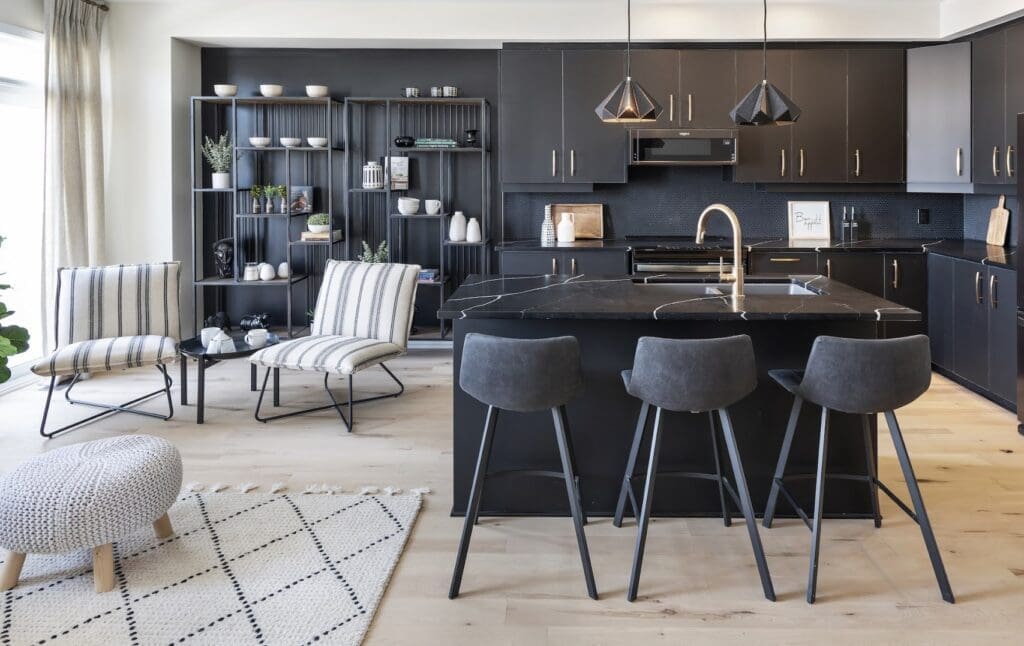Nowadays, climate change is an imminent danger to the health of humans, the flora and the fauna. At Potvin, we participate in the Toxic Reduction Act plan run by the Ontario Ministry of the Environment, which, according to their website, “aims to protect the health of people and the environment by: encouraging regulated facilities to reduce their use and creation of prescribed substances and provide public access to information and data reported by facilities under the program .”1
In the spirit of doing our part in reducing our ecological footprint, we decided to take the following three actions to accomplish this goal:
CABINET COMPONENTS LOW IN VOCS
The large majority of our cabinet components are low in VOCs (Volatile Organic Compounds). They are chemicals that can come from various sources, such as paint, glue, flooring materials, wood preservatives, varnishes and even cleaning products. They are not always detectable to the sense of smell. VOCs can threaten the air quality, and excessive exposure can affect your health depending on the type and level of VOCs present in your environment. By making changes in our manufacturing process, we are proud to say that our “VOC values have (…) dropped below reportable levels ”2 .
THE USE OF WATER-BASED PRODUCTS
According to the data of the Toxics Reduction Act, the reason why we were able to reduce our VOC levels drastically is because we are now using water-based finishing products. Basically, in the industry, you can either use “solvent-based” or “water-based” finishing products.
Solvent-based products “involves harsh chemicals”, “toxic fumes” and “an overwhelming odour” 3 where as the water-based products are the opposite and therefore, a good alternative for companies who want to have a greener outlook. Here’s what Bob Doucet, manager of the cabinetry shop, had to say about the switch:
“In 2012, we changed to water-based products. We wanted to find a way to be more productive and at the same time, we wanted to do it in a way that would respect the environment. We purchased new paint application machines which allowed us to switch to water-based products while producing faster and becoming greener, so it’s a two in one. The products are a little more expensive, but we consider the positive impact on the environment combined with the increased productivity to be a great trade off. ”
THE REDUCTION OF OUR TOLUENE VALUES
Toluene is the distinctive smell you can find in paint. It’s a “liquid chemical compound” 4 that can also be found in glues, paint thinners and gasoline. It is one of many VOCs. We were able to reduce our toluene values by 10 tons, which is a reduction of “ over 75% to well below criteria” 5 according to the Toxic Reduction Act plan.
In conclusion, “kitchen cabinets can off-gas formaldehyde and countless of other chemicals for years after they have been installed. In an effort to improve indoor air quality for our customers, Potvin has been using state-of-the-art water based paints, stains and lacquers for all wood products in our manufacturing process greatly reducing VOCs (Volatile Organic Compounds) emissions in our cutomer’s homes since 2012. We have found the results to be equal to or better than the more toxic products available and used in the industry. “Nugreen” (formaldehyde-free melamine) is also available on request to further reduce formaldehyde emissions in your home. ” 6 Also, we continue to work towards lowering our emissions even further, because caring for our customers, employees and the community is the driving philosophy behind our company and this culture of care goes into every kitchen we create.
SOURCES
- ( 2018, April 26 ). Toxics Reduction Program. Retrieved from https://www.ontario.ca/page/toxics-reduction-program
- Toxics Reduction Program – Facility Exit Record. https://www.ontario.ca/environment-and-energy/map-toxics-reduction#/reports/en/ExitRecord/8522/2012
- Solvent-Based Finishes Vs. Water-Based Finishes. Retrieved from http://woodwrights.net/blog/solvent-based-finishes-vs-water-based-finishes
- Garcia, N. What is Toluene? – Structure, Uses & Formula. Retrieved from https://study.com/academy/lesson/what-is-toluene-structure-uses-formula.html
- Toxics Reduction Program – Facility Exit Record. https://www.ontario.ca/environment-and-energy/map-toxics-reduction#/reports/en/ExitRecord/8522/2012
- Doucet, B. (2018, March 15). Personal interview.
- About us. Retrieved from https://potvinkitchens.com/about-us/
- Benjamin, H. (2016, April 21). What are VOCs, and how can I avoid them? Retrieved from http://www.greenhomeguide.com/know-how/article/what-are-vocs-and-how-can-i-avoid-them
- Volatile Organic Compounds (VOCs). Retrieved from https://toxtown.nlm.nih.gov/text_version/chemicals.php?id=31
- (2017, September 11). Volatile organic compounds. Retrieved from https://www.canada.ca/en/health-canada/services/air-quality/indoor-air-contaminants/volatile-organic-compounds.html
- [ Paul Cochrane ]. ( 2014, June 5 ). VOCs & Indoor Air Quality [ Video file ]. Retrieved from https://www.youtube.com/watch?v=DlbDI1ZfdTg
- Smith, N. Water-based Finishing for Cabinet & Millwork Shops. Retrieved from http://www.solutionsforwood.ca/_docs/profiles/TP_2009-04-W_Water-based_Finishing.pdf
- (2018, March 12). Toluene. Retrieved from https://www.dhs.wisconsin.gov/chemical/toluene.htm
- (2012, March 29). Toluene in Indoor Air. Retrieved from https://www.canada.ca/en/health-canada/services/environmental-workplace-health/reports-publications/air-quality/toluene-indoor-air-environment-workplace-health.html


